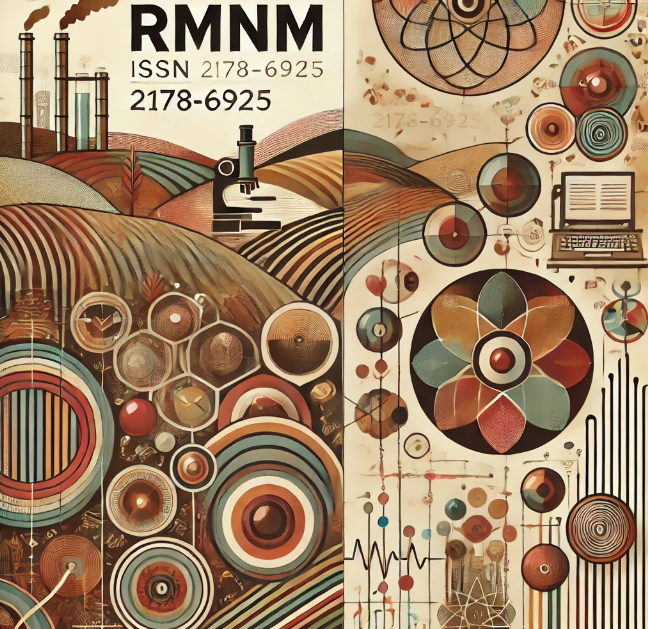RHEOLOGICAL STUDY OF Apis mellífera HONEY FROM TRACUATEUA, PARÁ
DOI:
https://doi.org/10.61164/rmnm.v3i3.2189Keywords:
Product of animal origin, Amazon, Physical propertiesAbstract
Honey is a viscous, aromatic and sweet liquid derived from the nectar of plants, collected by bees and
later stored by them as a denser liquid, which is a complex mixture of sugars, enzymes, minerals, amino
acids and vitamins with associated health benefits, honey also has a typical flavor, aroma and nutritional
quality. This research seeks to determine the rheological profile of Apis mellífera L. honey, acquired in
a municipality in the northeast of the state of Pará, by measuring its viscosity at different temperatures,
applying statistical tests to assess significant difference between the viscosity of the product at different
temperatures. It should be noted that that temperature is inversely proportional to the viscosity of the
honey, thus interfering with its flow. This analyses presented a quartic function (also known as a
polynomial of degree four) was the best fit, as it had a coefficient of determination of 0.9985, very close to 1.0. Therefore, it was possible to obtain a mathematical model that relates these two properties,
making it possible to calculate this viscosity in the temperature range from 10 to 60°C.
References
Allsop, K. A.; Miller, J. B. Honey revisited: a reappraisal of honey in pre-industrial diets.
British Journal of Nutrition, v. 75, n. 4, p. 513-520, 1996. DOI: https://doi.org/10.1079/BJN19960155
Associação Brasileira de Estudos das Abelhas - Abelha. (2023). Atlas da apicultura
no Brasil. Recuperado de https://abelha.org.br/atlas-da-apicultura-no-brasil/
Bath, P. K.; Singh, N. A comparison between Helianthus annuus and Eucalyptus
lanceolatus honey. Food Chemistry, v. 67, n. 4, p. 389-397, 1999. DOI: https://doi.org/10.1016/S0308-8146(99)00132-6
Bertoldi, F. C.; Gonzaga, L.; Reis, V. D. A. Características físico-químicas do mel de
abelhas africanizadas (Apis mellífera scutellata), com florada predominante de hortelãdo-campo (Hyptis crenata), produzido no Pantanal. In: Simpósio sobre recursos
naturais e sócio-economicos do pantanal, v. 4, n. 2004, p. 1-4, 2004.
Bhandari, B.; D'arcy, B.; Kelly, C. Rheology and crystallization kinetics of honey:
present status. International Journal of Food Properties, v. 2, n. 3, p. 217-226, 1999. DOI: https://doi.org/10.1080/10942919909524606
Cengel, Y. A.; Cimbala, J. M. Mecânica dos fluidos. 3ª ed. Amgh Editora, 2015.
EMBRAPA, MEIO NORTE. Apicultura: Sistema de Produção, 2003.
Gezahegn, T. Apiculture development strategies. Ministry of Agriculture and Rural
Development, Addis Ababa, Ethiopia, 2001.
Gois, G. C. et al. Composição do mel de Apis mellífera: Requisitos de qualidade. Acta
Veterinaria Brasilica, v. 7, n. 2, p. 137-147, 2013.
IBGE – INSTITUTO BRASILEIRO DE GEOGRAFIA E ESTATÍSTICA. Produção de
mel de abelha. Brasil: IBGE, 2021.
Junzheng, P.; Changying, J. General rheological model for natural honeys in China,
Journal of Food Engineering, Essex, v. 36, n. 2, p. 165-168, 1998. DOI: https://doi.org/10.1016/S0260-8774(98)00050-8
Lima, C. H. B.; Gomes, C. D. P.; de Souza, E. C.; Silva, A. dos S.. MEL DE TIÚBA
(Melipona fasciculata) – UM ESTUDO REOLÓGICO. Revista Multidisciplinar do
Nordeste Mineiro, v.02, n.1, 2024. DOI: https://doi.org/10.61164/rmnm.v2i1.1784 DOI: https://doi.org/10.61164/rmnm.v2i1.1784
Marchini, L. C. et al. Composição físico-química de amostra de méis de Apis mellífera
L. do Estado de Tocantins, Brasil. Boletim de Indústria Animal, v. 61, n. 2, p. 101-
, 2004.
Racowski, I. et al. Ação antimicrobiana do mel em leite fermentado. Revista Analytica,
v. 30, p. 115-117, 2007.
Ramos, J. M.; Carvalho, N. C. de. Estudo morfológico e biológico das fases de
desenvolvimento de Apis mellífera. Revista científica eletrônica de Engenharia
Florestal, v. 6, n. 10, p. 1-21, 2007. DOI: https://doi.org/10.7748/ns.21.21.10.s15
Sain, V. et al. Economics and importance of beekeeping. Biomedical Journal of
Scientific & Technical Research, v. 1, n. 7, p. 1-2, 2017.
Sodré, G. da S. et al. Caracterização físico-química de amostras de méis de Apis
mellífera L. (Hymenoptera: Apidae) do Estado do Ceará. Ciência Rural, v. 37, p. 1139-
, 2007.
Silva, C. L. Caracterização reológica e físico-química de méis de abelha (Apis
mellífera L.) do estado do Piauí. 2001. 87 f. Dissertação (Mestrado em Engenharia
Agrícola) - Universidade Federal de Campina Grande, Campina Grande, 2021.
Silva, K. de F. N. L. et al. Comportamento reológico do mel de Apis mellífera do
município de Tabuleiro do Norte-CE. Revista Brasileira de Tecnologia
Agroindustrial, v. 4, n. 1, 2010.
Van Wazer, J. R.; Lyons, J.W.; Kim, K. Y.; Colwell, R. E. Viscosity and flow
measurement: a laboratory handbook of rheology. New York, Interscience
Publishers, 1963, 406 p.y.
Downloads
Published
How to Cite
Issue
Section
License
Copyright (c) 2024 Revista Multidisciplinar do Nordeste Mineiro

This work is licensed under a Creative Commons Attribution-NonCommercial-ShareAlike 4.0 International License.




